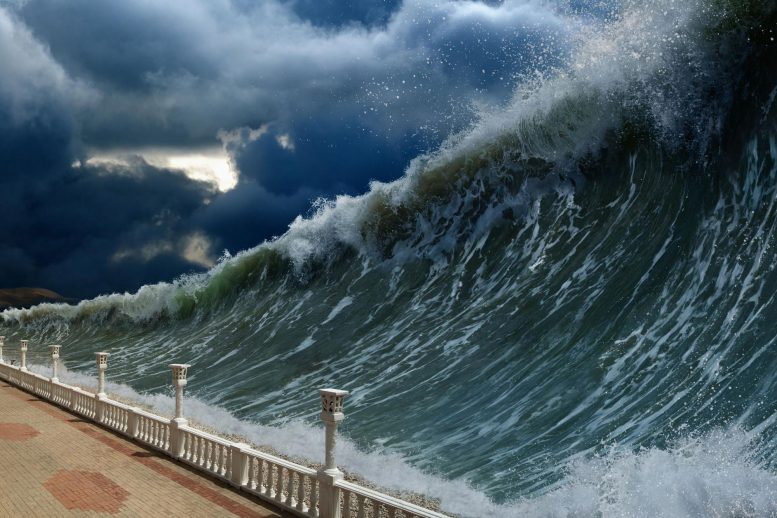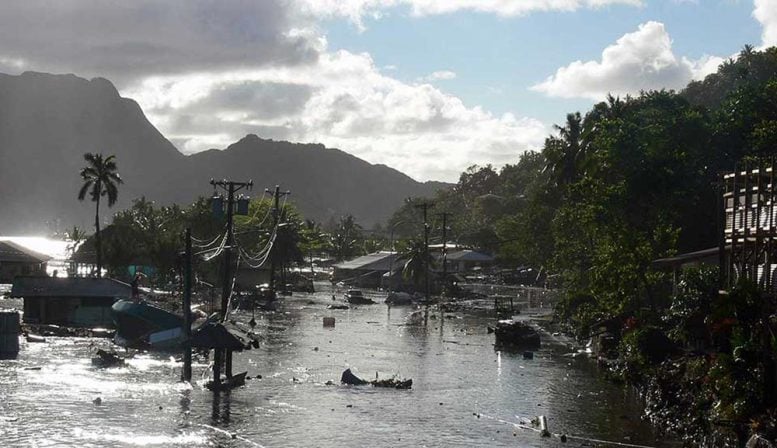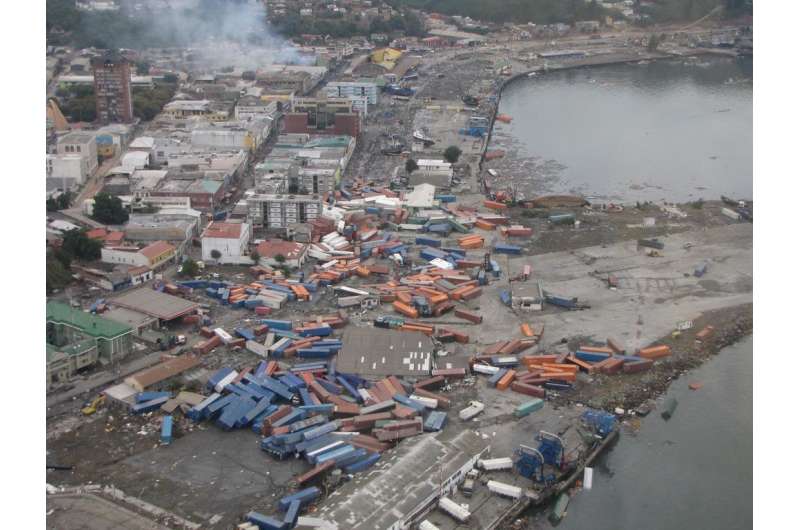Resolving a Dangerous Conundrum: Earthquake Depth Impacts Potential Tsunami Threat

Earthquakes of similar magnitude can cause tsunamis of greatly varying sizes. This commonly observed, but not well-understood phenomenon has hindered reliable warnings of local tsunamis.
Research led by University of Hawai‘i (UH) at Manoa scientists provides new insight that connects the characteristics of earthquakes—magnitude, depth where two tectonic plates slip past each other and the rigidity of the plates involved—with the potential size of a resulting tsunami.
Previous researchers identified a special class of events known as tsunami earthquakes, which produce disproportionately large tsunamis for their magnitude. Kwok Fai Cheung, professor of Ocean and Resources Engineering in the UH Manoa School of Ocean and Earth Science and Technology (SOEST), Thorne Lay from the University of California – Santa Cruz, and co-authors discovered a straightforward explanation for this conundrum. Their findings were published recently in Nature Geoscience.
Using computer models, the team incorporated physical processes that produce earthquakes and tsunamis with a wide range of observations of real-world events, including those classified as tsunami earthquakes. The model results demonstrated that for a given earthquake magnitude, if the rupture extends to shallow depth in the less rigid part of the plate, the resulting tsunami is larger than if the rupture is deeper.
“In a subduction zone, the upper plate is thinner and less rigid than the underthrusting plate near the trench,” explained Cheung. “A concentrated near-trench or shallow rupture produces relatively weak ground shaking as recorded by seismometers, but the displaced water in the overlying deep ocean has enhanced energy and produces shorter tsunami waves that amplify at a high rate as they move toward the shore.”
“Earthquake and tsunamigenic processes are complex, involving many factors that vary from one event to another,” said Lay, professor of Earth and Planetary Sciences at UC Santa Cruz. “We utilized a simplified numerical model to isolate key earthquake parameters and evaluate their importance in defining tsunami size.”

On September 29, 2009, a tsunami caused substantial damage and loss of life in American Samoa, Samoa, and Tonga. The tsunami was generated by a large earthquake in the Southern Pacific Ocean. Credit: NOAA
Having verified that the presence of shallow earthquake rupture can be a more significant factor than the earthquake magnitude for the resulting tsunami size led the researchers to an important question: Can earthquake magnitude continue to be used as the primary indication of potential tsunami impacts?
“The practice of using earthquake magnitude to estimate potential tsunami threat has led to poor predictive capability for tsunami impacts, and more information about the source is required to do better,” said Cheung.
An important aspect of this interdisciplinary research is the synergy of expertise in seismology, with Lay, and tsunamis, with Cheung’s research group, applied to a large set of observations. This study motivates development of new seismological and seafloor geodesy research that can rapidly detect the occurrence of shallow rupture in order to achieve more reliable tsunami warning.
While shorelines throughout the Pacific Ocean and along the “Ring of Fire” are vulnerable to tsunamis, the situation is most critical for coastal communities near the earthquake, where the tsunami arrives quickly—when detailed information about the earthquake is not yet available.
Cheung and Lay continue their collaboration to investigate prehistorical, historical, and future tsunami events to better understand the hazards posed to coastal communities and enable more accurate warning systems.
Reference: “Tsunami size variability with rupture depth” by Kwok Fai Cheung, Thorne Lay, Lin Sun and Yoshiki Yamazaki, 13 December 2021, Nature Geoscience.
DOI: 10.1038/s41561-021-00869-z
Tsunamis' magnetic fields are detectable before sea level change

A new study finds the magnetic field generated by a tsunami can be detected a few minutes earlier than changes in sea level and could improve warnings of these giant waves.
Tsunamis generate magnetic fields as they move conductive seawater through the Earth's magnetic field. Researchers previously predicted that the tsunami's magnetic field would arrive before a change in sea level, but they lacked simultaneous measurements of magnetics and sea level that are necessary to demonstrate the phenomenon.
The new study provides real-world evidence for using tsunamis' magnetic fields to predict the height of tsunami waves using data from two real events—a 2009 tsunami in Samoa and a 2010 tsunami in Chile—that have both sets of necessary data. The new study was published in AGU's Journal of Geophysical Research: Solid Earth, which focuses on the physics and chemistry of the solid Earth.
The study confirms the magnetic field generated by a tsunami arrives ahead of sea-level change and that its magnitude can be used to estimate the tsunami's wave height. How much earlier the magnetic field arrives depends on water depth, but in their results, the study authors found the early arrival time to be about one minute prior to sea level change over a 4,800-meter deep sea.
This information could provide earlier disaster warning if incorporated into tsunami risk models, potentially saving lives.
"It is very exciting because in previous studies we didn't have the observation [of] sea level change," said Zhiheng Lin, senior study -author and a geophysicist at Kyoto University. "We have observations [of] sea level change, and we find that the observation agrees with our magnetic data as well as theoretical simulation."
The research team looked at simultaneous measurements of sea level change from seafloor pressure data and magnetic fields during the two tsunamis. They found that the primary arrival of the magnetic field, similar to that of the beginning of a seismic wave, can be used for the purpose of early tsunami warning. The tsunami-generated magnetic field is so sensitive that even a wave height of a few centimeters can be detected.
"They did something that basically needed to be done," said Neesha Schnepf, a researcher of geomagnetics at the University of Colorado, Boulder who was not involved in the study. "We've needed a study that compared the magnetic field data with the sea level change from the pressure data, and I'm pretty sure they're the first to really compare how well the sea level from magnetic field matches the sea level from pressure, so that's definitely very useful."
When the researchers compared the horizontal and vertical components of the tsunami magnetic field with sea level change, they found that both components can precisely predict tsunami sea level change, if models include good estimates for ocean depth and the electrical structure below the seafloor.
This relationship between magnetic fields and wave height can be used to improve tsunami source models, which estimate the initial sea surface topography of a tsunami and then predict water wave arrival time and wave height—important data for informing disaster readiness and response.
The difficulty of maintaining already limited observational stations means these types of data from tsunamis are often not available. Furthermore, these findings only apply in deep-sea and not coastal environments, where deep water in the region filters out environmental noise to allow the tsunami signal to be detected.
However, providing warning for these severe events—which have the potential to cause intense damage to large areas—makes the predictions worthwhile, said Lin.
"I think the practical goal would be if your ability to model tsunamis is so improved … you could come up with much better predictions of what areas might need to be warned [and] how badly it might hit certain places," Schnepf said.
Earthquake depth impacts potential tsunami threat
More information: Zhiheng Lin et al, Direct Comparison of the Tsunami‐Generated Magnetic Field With Sea Level Change for the 2009 Samoa and 2010 Chile Tsunamis, Journal of Geophysical Research: Solid Earth (2021). DOI: 10.1029/2021JB022760
Journal information: Journal of Geophysical Research: Solid Earth
Provided by American Geophysical Union

No comments:
Post a Comment